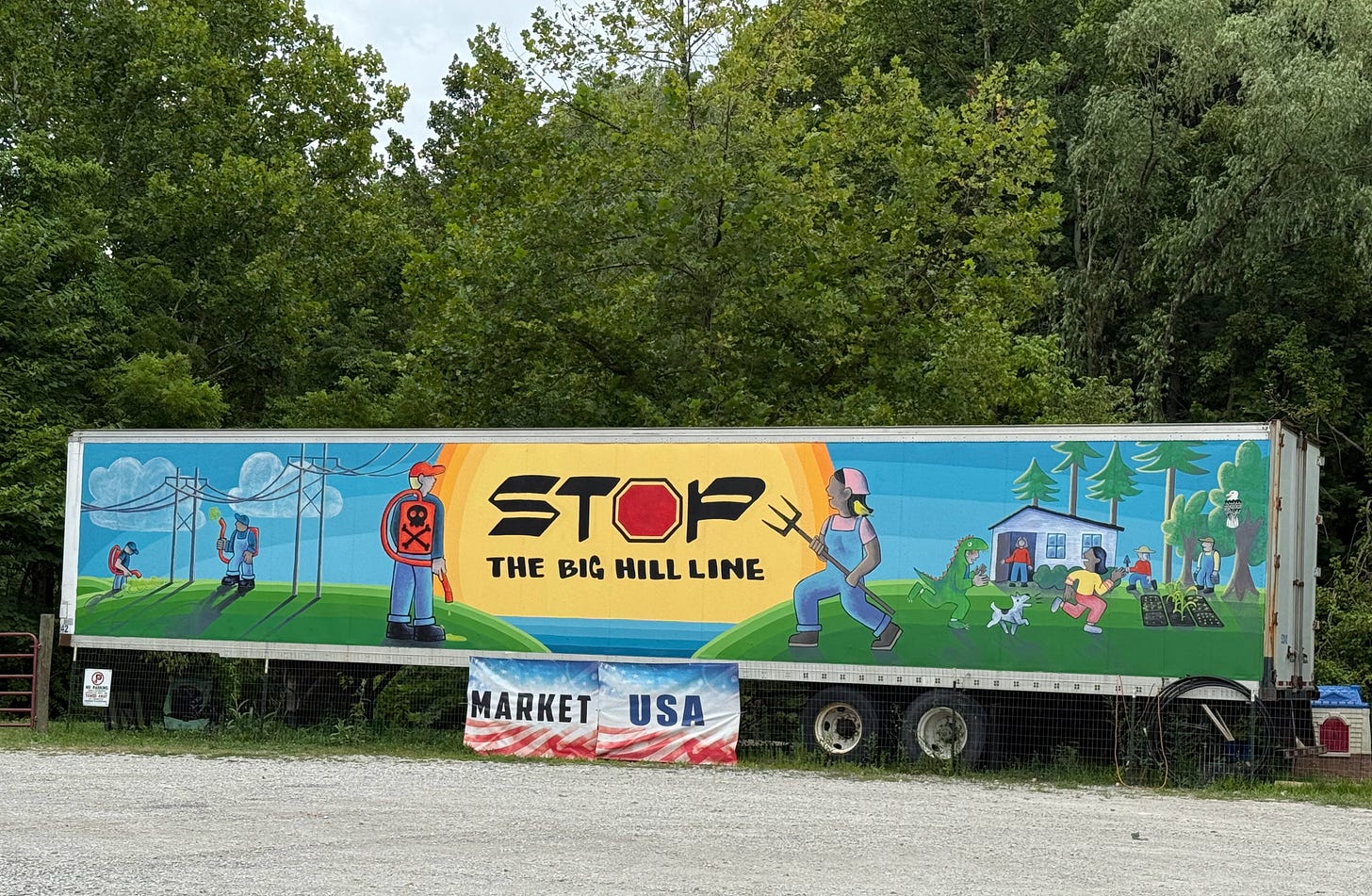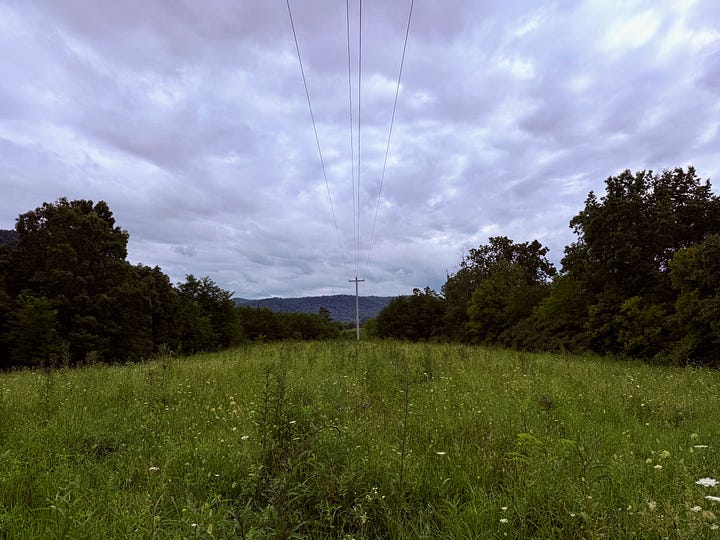'Big Hill Line opposition is fear-mongering' resident says
Supporter of EKPC transmission line through area speaks out

Part 2 of an ongoing series on the Big Hill Line.
BIG HILL—It began with the mural.
Michelle Giles (previously Morgan) said when she saw the protest mural painted on an unused semi-trailer at the junction of County Rd 21 and Hwy 421, it immediately reversed her opposition to the construction of nearly nine miles of a 69 kilovolt transmission line through Red Lick, Big Hill, and a portion of northern Jackson County, by the Eastern Kentucky Power Cooperative. EKPC has already begun construction on the line, despite its opposition.
“That mural is so stupid,” Giles, a Big Hill resident whose 55 acres will be crossed by the line entirely, from North to South, told The Edge in an interview. “I think so every time I drive past that stupid thing. It is just fear-mongering.”
‘Nothing is a lie’
The stylized mural depicts a transmission line to the left, and to the right, a small vegetable garden and cozy family home tucked into the trees with an eagle perched on a branch over head. A child is dressed as Godzilla, perhaps a reference to the way the transmission line poles and arms look like a monster, and is chasing another child. A Jack Russell joins in the chase, with bark lines coming from his open mouth.
Also at the mural’s center, is a woman defending the scene with a pitch fork aimed at a man with a toxic chemical pack on his back (that it is poison is indicated by the skull and cross bones painted on the pack) as he prepares to spray herbicides along the easement of the power line.
“No one is coming out [to Big Hill] with packs of poison on their backs, spraying them at kids. Nor is some woman going to defend her family with a pitch fork,” Giles said. “I mean, my goodness. You just look at that, and you say, this has no reality to it whatsoever. It’s manipulative, and just meant to create fear and hysteria because nothing else they do is going to work.”
The “they” are local artists Bugz Fraugg and Lilian “Lili” Mora, two of dozens of activists who oppose the line.
“I admit, we were intentionally heavy handed in some of the visual metaphors,” Fraugg told The Edge in a text. “But to say she was being manipulated by opponents of the line is pretty extreme. And nothing depicted there is a lie, either.”
Prior to her encounter with the mural, Giles, who has a pacemaker, said she had allowed herself to be “tricked” by those opposing the line, into fearing that it would create health hazards for her.
She said she has since been told by both EKPC officials and her own physician that the line will not pose any danger to her. She said she also believes that opponents of the line are selfish and do not understand its role in providing opportunities for Kentuckians elsewhere.
Industry v. residential
“[EKPC] wants to upgrade their structures because that is going to bring employment opportunities to a new community, or make future utilities possible, or offer new technologies for industry so people can have jobs,” Giles said. “Well, I am open to that. We need to give people as many opportunities as we can.”
One of the chief arguments against the line has been that EKPC is building only a 69kV line now so it can avoid justifying it to the state’s Public Service Commission. The PSC’s role is to ensure utilities act in the public interest.
A PSC official told The Edge in a background interview that EKPC is within its rights to build the line without PSC oversight, since the line does not meet the threshold for the PSC to sign off on it. State statute requires the PSC become involved in all lines of 138kV or more. The Big Hill line is half that size.
Another argument of the opposition has been that once the 69kV line is built, there is nothing to stop the utility from building a second one of the same size and connecting to the Big Hill Line, effectively creating a 138 kV line without ever having to argue their case before the Commission.
On the website created by opponent of the Big Hill poses the question as to whether EKPC has a further agenda to support industrial, not residential power needs, even if the utility claims this is for residential need only.
“Red Lick and Big Hill are not experiencing rapid development. But, the Duncannon Lane expansion and North Berea are growing rapidly, particularly attracting the interest of large energy users,” the website read. “In Madison County, building permits for large commercial development are being granted without energy infrastructure to support them.”
Among the large energy users referenced include data centers, EV battery manufacturing and crypto-mining, all of which increasingly have been built across the state, encouraged by the Beshear administration.
The opponents’ website also points to testimony given by representatives of EKPC to the PSC suggesting that the utility knows industrial demand will impinge on the residential market for power.
Giles is unmoved by any of these claims.
“The opposition, they are very organized,” Giles said in the interview. “But I know they don’t live here. I mean, I think they are sincere about they believe, but my opinion is that what they believe isn’t necessarily accurate.”
If it turns out the line is to support industry instead of residential power, Giles said she still thinks that is for the greater good. “If it’s to allow industry to expand, or for utilities for people, great. It’s all about opportunity,” Giles said.
Broad opposition
Opposition to the line is indeed broad. Activists living both near and nowhere near the line are among those who are against it. The opposition is broad, encompassing not only activists, but property owners whose land the line will cross and outdoor tourism businesses based in the area.
The opponent with the biggest firepower, however, is Berea College. The College refused the utility access to its miles of forested property in Big Hill and vicinity. In turn, EKPC sued the College in June for access per eminent domain laws that favor the “public good” over private property owners. EKPC seeks to build the line on less than a mile of the forest.
EKPC’s argument has been steadfast that the Big Hill Line is to provide reliable residential service to the area. The College’s stance, as stated in a letter shared with The Edge, and addressed to the US Department of Agriculture, is that even if the line doesn’t meet the PSC threshold, why isn’t the utility finding alternative solutions that do not adversely impact residents or the environment and wildlife?
A study conducted by the local office of the US Fisheries and Wildlife Department, found there would be negative impact on a variety of bat species living in the woods.
The USDA is the federal government agency tasked with overseeing rural electric concerns.

‘Respectful, professional, transparent’
The Big Hill Line will expand the current line running through Giles’s property, one that was previously negotiated by Blue Grass Energy, an EKPC subsidiary, decades ago, according to Giles. She said officials from EKPC have told her it will be taller than the one already there, a fact she said she just accepts.
“I am not naive about this. I already have a line running through my property. It’s not an issue to me. It’s not going to make a drastic difference,” Giles said, adding that she has legal representation that is interested in helping her preserve her land’s “integrity” and in particular, to protect a small grove on her horse farm, that she calls her “happy place.”
“I got representation to help me with that, not to see if I could jack up the price for using my land,” she said.
EKPC has been negotiating the cost of right of ways with affected property owners, most of which did not wish to speak on the record or for attribution. At least one property owner other than the College has been sued by the utility for access. Another said they had reached a settlement with the utility, but are bitter about having been put in the situation.
Giles said that her dealings with EKPC officials as they have been in negotiations have been nothing but “respectful, professional, and transparent.”


Lone voice
The Edge contacted multiple individuals in an attempt to find other proponents of the Big Hill Line. There was none discovered.
However, according to EKPC, in the aggregate, Giles is in the majority.
“In the vast majority of cases where a transmission line crosses private property, EKPC and the property owner came to a mutually satisfactory agreement on an easement so the cooperative can locate its poles and wire on the property and ensure safe, reliable service,” Nick Comer, EKPC spokesperson, told The Edge in an email.
Giles said she knows that in her neighborhood at least, she’s alone in her stance on the line, but that she is fine with that. She’s just telling it the way she sees it, not evangelizing, she said.
“I stand behind what I am saying. I will get some pushback, I’m sure of that, but that’s alright. My whole desire is to be authentic and transparent as I can be in all of my interactions,” Giles said. “I don’t need to go out there and try and change people’s minds.”
This story has been updated to note Giles’ 55 acres.
This is an ongoing series. Next week: What is at stake for EKPC?
Investigative reports like this one need funding to produce, even if they are gratifying to report. The Edge NEEDS your support if it is to continue bringing you quality, reliable, local journalism. Please subscribe today. Thank you!
